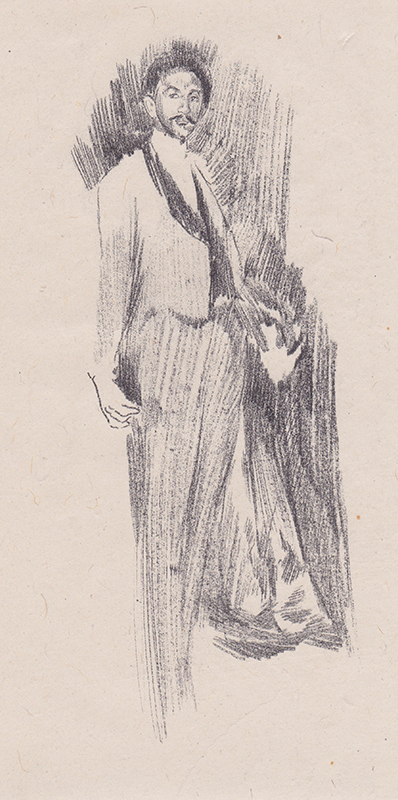
19th, 20th & 21st Century Fine Prints
707-546-7352 · fax 707-546-7924 · web: www.annexgalleries.com · email: artannex@aol.com
Count Robert de Montesquiou (after James McNeill Whistler) by Beatrix Godwin Whistler

Count Robert de Montesquiou (after James McNeill Whistler)
Beatrix Godwin Whistler
Title
Count Robert de Montesquiou (after James McNeill Whistler)
Artist
Beatrix Godwin Whistler
1857 - 1896 (biography)Year
1894
Technique
transfer lithograph
Image Size
7 3/4 x 2 15/16" image size
Signature
unsigned, as usual
Edition Size
not editioned, proofs only; RARE
Annotations
Reference
Levy 132 (J.M. Whistler credited), AIC 84, Fig. 84a., pg. 265, A Catalouge Raisonne I, The Lithographs of James McNeill Whistler, The Art Institute of Chicago, in association with the Arie and Ida Crown Memorial, NE2312.W45A4 1998; Way 139.
Paper
thin, grayish ivory China
State
i/i
Publisher
Inventory ID
20893
Price
SOLD
Description
Whistler met Comte Robert de Montesquiou-Fezensac in 1885, and painted his portrait in 1891/92, which he exhibited as 'Arrangement in Black and Gold: Comte Robert de Montesquiou-Fezensac' in May 0f 1894. The portrait proved a great critical success, and the artist was approached by the publishers of several periodicals interested in reproducing it. Whistler and his wife Beatrix both produced transfer drawings of the portrait. However, Whistler was not satisfied with the printed results and a published edition of the lithograph did not appear. Whistler referred to his wife's lithographs as 'far more beautiful' than his own. Quoted from The Art Institute of Chicago (AIC), The Lithographs of James McNeill Whistler, Vol. I catalogue raisonne, pg. 263 regarding this work: "The existence of two lithographs by Beatrix Whistler has long complicated the cataloguing of Whistler's Count Robert de Montesquiou, No 2., Way (1896, 1905) catalogued one of her images (Way 139) as the work of Whistler's hand, and Kennedy perpetuated the error in his revised catalogue of 1914. As late as 1975, Levy catalogued and illustrated both of Beatrix's Montesquiou lithographs (Levy 132, 134) as versions drawn by Whistler himself. Collectors, dealers, and museums have been misled not only by these errors of cataloguing, but also by Way's description of the "vigorous down strokes" in Count Robert de Montesquiou, No. 2 (Way 138); both of Beatrix's images [figs. 84a, 84b] demonstrate more emphatic patterns of "down strokes" than Whistler's lithograph. In addition to their pronounced vertical strokes, Beatrix's images are easily recognizable because neither reproduces the butterfly signature that is present on the canvas itself, and which was repeated in Whistler's lithographic rendering of it."
